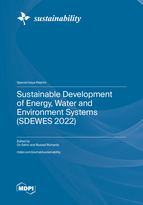Sustainable Development of Energy, Water and Environment Systems (SDEWES 2022)
A special issue of Sustainability (ISSN 2071-1050).
Deadline for manuscript submissions: closed (28 February 2023) | Viewed by 30941
Special Issue Editors
2. Faculty of Medicine, University of Queensland, Herston, QLD 4006, Australia
Interests: systems dynamics modelling; operations research; natural resource management; decision support systems; water resources engineering; geospatial information systems
Special Issues, Collections and Topics in MDPI journals
Interests: coastal systems and ecosystem services; social-ecological modelling; system dynamics modelling; serious games and gamification; Bayesian modelling; decision support systems; app development
Special Issues, Collections and Topics in MDPI journals
Special Issue Information
Dear Colleagues,
Ever since 2002, when the first Conference on Sustainable Development of Energy, Water and Environment Systems (SDEWES) was held in Dubrovnik, the SDEWES Conference series has been providing a worldwide forum for scientists and those interested in sustainability, to share the state of the art, future directions and priorities. SDEWES is dedicated to the advancement and dissemination of knowledge on methods, policies, and technologies for increasing the sustainability of development by de-coupling growth from the use of natural resources and by transitioning to a knowledge-based economy.
Considering all the economic, environmental, and social pillars of sustainable development, one of the main issues of the coming decades is to improve efficiencies by integrating various life-supporting systems, using excess from one, as a resource in another in the correct moment. Integrating electricity, heating, cooling, transport, water, buildings, waste, wastewater, industry, forestry and agriculture systems will be pivotal towards sustainable development. To make efficiency improvements happen, political aspects of sustainable development need to be considered as well, thus implying the need for taking account of, among others, sustainable development goals, resource and political security, long term planning, the role of political leaders and voters, energy democracy, community and citizen participation in the energy transition.
SDEWES has maintained high publishing standards with more than 2500 research articles published in leading journals. In 2022, the SDEWES Conference series involved three scientific conferences based on the 5th South East European, 3rd Latin American and 17th Conferences on SDEWES in Vlorë (Albania), São Paulo (Brazil) and Paphos (Cyprus), containing over 700 contributions and 20 special sessions. MDPI-Sustainability journal has continued its cooperation with SDEWES, launching a special issue dedicated to the 2022 Conferences. Taking it into consideration, the SI is meant to provide an opportunity for researchers in a wide range of areas to originate, discuss, share, and disseminate new ideas. Sustainability also offers a perfect platform for interdisciplinary and multi-cultural evaluation of complex systems.
Dr. Oz Sahin
Dr. Russell Richards
Guest Editors
Manuscript Submission Information
Manuscripts should be submitted online at www.mdpi.com by registering and logging in to this website. Once you are registered, click here to go to the submission form. Manuscripts can be submitted until the deadline. All submissions that pass pre-check are peer-reviewed. Accepted papers will be published continuously in the journal (as soon as accepted) and will be listed together on the special issue website. Research articles, review articles as well as short communications are invited. For planned papers, a title and short abstract (about 100 words) can be sent to the Editorial Office for announcement on this website.
Submitted manuscripts should not have been published previously, nor be under consideration for publication elsewhere (except conference proceedings papers). All manuscripts are thoroughly refereed through a single-blind peer-review process. A guide for authors and other relevant information for submission of manuscripts is available on the Instructions for Authors page. Sustainability is an international peer-reviewed open access semimonthly journal published by MDPI.
Please visit the Instructions for Authors page before submitting a manuscript. The Article Processing Charge (APC) for publication in this open access journal is 2400 CHF (Swiss Francs). Submitted papers should be well formatted and use good English. Authors may use MDPI's English editing service prior to publication or during author revisions.
Keywords
- sustainability comparisons and measurements
- green economy and better governance
- sustainable resilience of systems
- environmental policy and management
- energy policy
- energy systems
- renewable energy sources
- waste and wastewater treatment
- water-energy nexus
- energy and water efficiency







